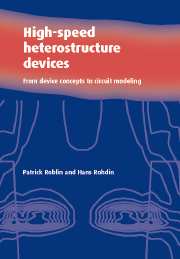Book contents
- Frontmatter
- Contents
- Preface
- Acknowledgements
- List of abbreviations
- Introduction
- 1 Heterostructure materials
- 2 Semiclassical theory of heterostructures
- 3 Quantum theory of heterostructures
- 4 Quantum heterostructure devices
- 5 Scattering processes in heterostructures
- 6 Scattering-assisted tunneling
- 7 Frequency response of quantum devices from DC to infrared
- 8 Charge control of the two-dimensional electron gas
- 9 High electric field transport
- 10 I – V model of the MODFET
- 11 Small- and large-signal AC models for the long-channel MODFET
- 12 Small- and large-signal AC models for the short-channel MODFET
- 13 DC and microwave electrothermal modeling of FETs
- 14 Analytical DC analysis of short-gate MODFETs
- 15 Small-signal AC analysis of the short-gate velocity-saturated MODFET
- 16 Gate resistance and the Schottky-barrier interface
- 17 MODFET high-frequency performance
- 18 Modeling high-performance HBTs
- 19 Practical high-frequency HBTs
- Index
5 - Scattering processes in heterostructures
Published online by Cambridge University Press: 06 July 2010
- Frontmatter
- Contents
- Preface
- Acknowledgements
- List of abbreviations
- Introduction
- 1 Heterostructure materials
- 2 Semiclassical theory of heterostructures
- 3 Quantum theory of heterostructures
- 4 Quantum heterostructure devices
- 5 Scattering processes in heterostructures
- 6 Scattering-assisted tunneling
- 7 Frequency response of quantum devices from DC to infrared
- 8 Charge control of the two-dimensional electron gas
- 9 High electric field transport
- 10 I – V model of the MODFET
- 11 Small- and large-signal AC models for the long-channel MODFET
- 12 Small- and large-signal AC models for the short-channel MODFET
- 13 DC and microwave electrothermal modeling of FETs
- 14 Analytical DC analysis of short-gate MODFETs
- 15 Small-signal AC analysis of the short-gate velocity-saturated MODFET
- 16 Gate resistance and the Schottky-barrier interface
- 17 MODFET high-frequency performance
- 18 Modeling high-performance HBTs
- 19 Practical high-frequency HBTs
- Index
Summary
Ships would be safer if they stayed in the shelter of harbors. They are however built for venturing in deep seas.
AnonymousIntroduction
So far our study of quantum heterostructure devices in Chapter 4 has assumed that the devices were small compared to the mean free path of the electron. Transport in this type of device is referred to as ballistic transport. In real crystals the electron is always subjected to some type of scattering. In Chapter 6 we will study the impact of scattering on the electron wave-function and develop a simple three-dimensional quantum transport theory. In preparation for this analysis, we must first study the scattering mechanisms to which an electron is subjected.
Various scattering mechanisms exist in semiconductors. We will consider first scattering by the lattice vibrations, and, in particular, discuss polar, acoustic, and intervalley scattering. Next, we will turn our attention to scattering processes specific to heterostructures and discuss interface roughness scattering and alloy scattering. Finally, we will conclude this chapter with a discussion of electron–electron scattering.
Note that quantum heterostructures such as resonant tunneling diodes (RTDs), superlattices, and quantum wells (e.g., modulation doped field-effect transistors (MODFETs)) are usually undoped to minimize impurity scattering. Therefore impurity scattering is usually small compared to polar scattering and interface roughness scattering.
Phonons and phonon scattering
A crystal can be represented as a network of masses connected by springs. The masses are the atoms and the springs the covalent bonds between the atoms (see Figure 5.1).
- Type
- Chapter
- Information
- High-Speed Heterostructure DevicesFrom Device Concepts to Circuit Modeling, pp. 148 - 176Publisher: Cambridge University PressPrint publication year: 2002

